Introducing Arduino & Dino
The Arduino is a small board which features a programmable microprocessor and several pins you can use to interact with the world.
What does that mean to you? It’s a cool way to write programs which affect the physical world. In this tutorial, we’ll play with some neat lights and see how the programming instructions affect what you observe.
Fundamentals
LEDs
An LED is a small light with two wires. When one side is connected to a positive electrical source and the other to negative (or "ground"), the LED lights up.
Is It Dangerous?
These are not dangerous. The electrical voltage we’re using here is so low that even if you intentionally tried to electrocute yourself, you probably couldn’t even feel it. Don’t be concerned.
LED Structure
It looks like this:
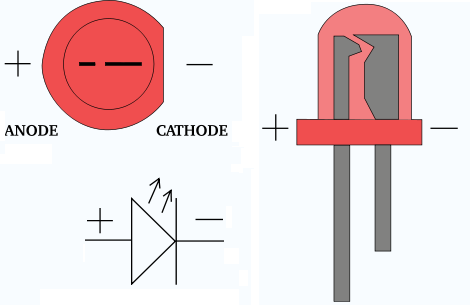
The led has two stiff wires that we’d prefer not to bend. The shorter one goes to the ground or negative line – this is called the "cathode". The other, longer pin, goes to the positive line – this is called the "anode".
Let There Be Light!
Let’s build a simple circuit that involves no programming, just wiring.
Find the following materials in your kit:
- Arduino board, looks like a small computer
- USB cord
- Breadboard (covered in holes to plug wires into)
- 3 long wires (1 red, 1 black, 1 green – you can change colours if necessary)
- 1 red LED
- 1 330Ω resistor (little brown pill with these stripes: orange, orange, brown, gold)
With those materials, build this circuit:
- Connect the USB cord to your computer and the Arduino. You should see the small green "ON" led light up on the board.
- Put one end of the red wire into the hole on the Arduino marked 5V.
- Put the other end of the red wire into any hole in the "+" column on the left side of the breadboard.
- Put one end of the black wire into the hole marked GND by the voltage (it will say "POWER" above it)
- Put the other end of the black wire into any hole in the "-" column on the left side of the breadboard
- Put the green wire into the hole on the Arduino labeled "13"
- Put the other end of the green wire into row "2" column "e" on the breadboard.
- Put the wire coming out of the resistor’s gold-banded side into row "3" column "a" (you may bend the wire to a 90º angle to get it to fit)
- Put the wire coming out of the resistor’s orange-banded side into any of the holes in the "-" column that the black wire is connected to.
- Put the LED’s long, positive, wire into row "2" column "c"
- Put the LED’s short, negative, wire into row "3" column "c"
- The flat side of the LED should be facing row 3.
- Let there be light! (…if there isn’t, move the end of the green wire from hole "13" to any of the holes in the "+" column – if there is still no light, then check that everything is right. You may also want to try wiggling the wires to make sure they are connected to the boards.)
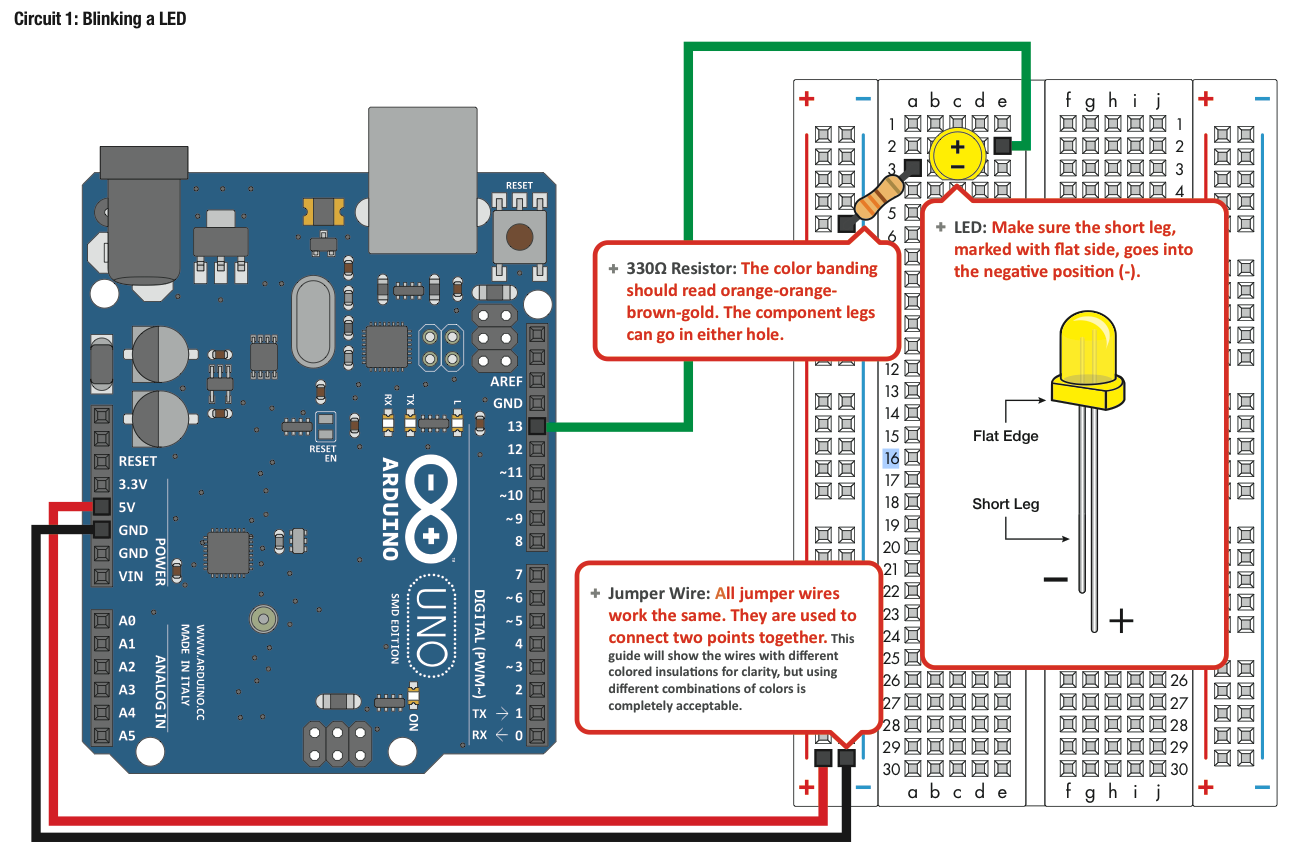
Prepare environment
To be in command of this light, we’ll need to write a program that interacts with the Arduino. We’ll need some software that can talk to it. And we’ll write some files to tell it what to do. Lets set those up now.
Download / set up Arduino software
We can write programs to interact with our Arduino, controlling LEDs and reading from sensors. If you buy extra parts, you can even control motors to make things move.
Let’s start by downloading the Arduino software that will allow your computer to push code to the Arduino. Visit http://www.arduino.cc/en/Main/software and click on the download link for your operating system.
Open the "Arduino" application.
We need to connect the software to our Arduino. Tell it what kind of Arduino we have by going to "Tools" and then "Board" and selecting "Arduino Uno".

Now we need to tell it where to find the Arduino by going to "Tools" and then "Serial Port" and selecting "/dev/tty.usbmodem####" or "/dev/tty.usbserial####" (the "#"s will be a seemingly random string of numbers and possibly letters that can vary)
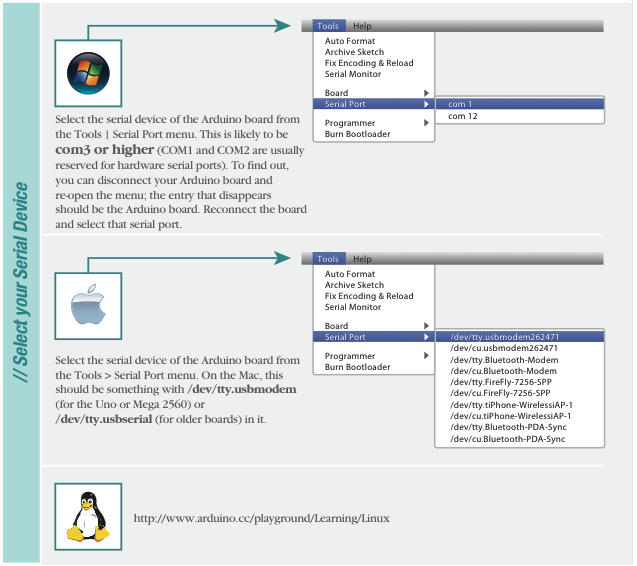
Create a directory for our files
We’ll make a new folder to store the files we use for this tutorial.
This can be done in a command prompt by typing
mkdir community_night_arduino and then moving into that directory with
cd community_night_arduino. Where to make this folder is up to you.
Everything we do on the command line, we’ll do in this directory.
Install the "dino" gem
Thanks to a gem (a collection of Ruby code) written by Austin Vance we can use Ruby to interact with our Arduino.
Get the gem by typing this in your command prompt:
1
| |
You’ll see something like this:
1 2 3 4 | |
It doesn’t need to be exactly the same. The important thing is that you don’t see any errors.
Bootstrap Dino
We need to load a "bootstrap" program onto the Arduino board that will let us manipulate it from Ruby.
In your command prompt window, type:
1
| |
This will create a folder named "du".
- If you previously moved the green wire from hole "13" to the "+" column to see the LED turn on, then move it back to hole "13" now.
- We need to tell the software to give us information about what it is doing.
Go to the "Preferences" dialog and check the boxes for "verbose" output
during "compilation" and "uploading"
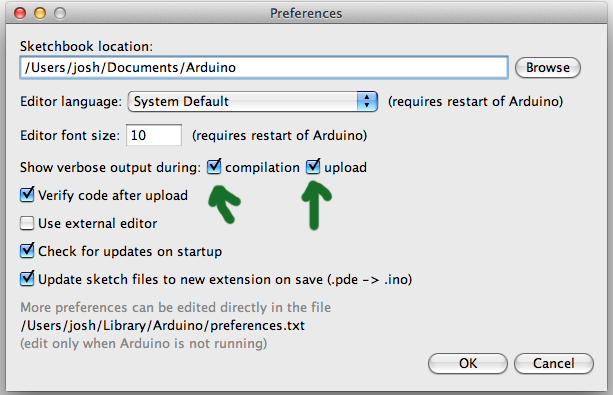
- Open the
.../du/du.inofile in the Arduino software. - In the file window, at the top left, click the right-arrow-in-a-circle button for "Upload"
- If you see "avrdude done. Thank you." then you can skip the rest of these instructions.
- If instead, there is an error in the bottom window that looks like this:
Then when we upload code, it is interfering with the code that was previously loaded onto the board.
1 2 3 4 5 6 7 8
Using Port : /dev/tty.usbserial-AM01VD5Q Using Programmer : arduino Overriding Baud Rate : 115200 avrdude: Send: 0 [30] [20] avrdude: Send: 0 [30] [20] avrdude: Send: 0 [30] [20] avrdude: serrecv(): programmer is not responding avrdude: stk500recv(): programmer is not responding There are two ways to fix it:
- We can press the "RESET" button on the Arduino as soon as we see "Overriding Baud Rate". This will allow it to accept the program we are uploading.
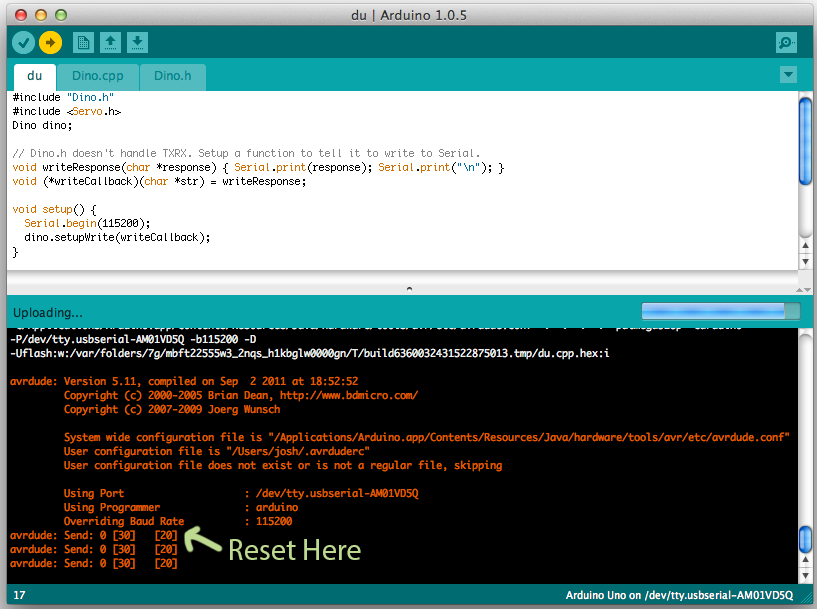 2. There are newer drivers that we can use to talk to it
which have fixed this issue.
* For Mac OS X, download 2.2.18
here.
* Double click the dmg to mount it.
* right-click FTDIUSBSerialDriver104105106107 and select "open"
(note that you must right-click it, double-clicking won’t work)
2. There are newer drivers that we can use to talk to it
which have fixed this issue.
* For Mac OS X, download 2.2.18
here.
* Double click the dmg to mount it.
* right-click FTDIUSBSerialDriver104105106107 and select "open"
(note that you must right-click it, double-clicking won’t work)- It will inform you that the program is from an unidentified developer, which basically means that Apple hasn’t vetted the software as it has with programs we install in the App Store.
- Click "Open" to acknowledge this and continue installing.
- Accept the default install settings and progress through the wizard.
- Restart the Arduino software to get it to use the new drivers. (Mine still had the same issue for a few minutes after restarting).
You’ll see a lot more output this time, concluding in "avrdude done. Thank you."
Write our first program
Let’s try out a very small program and see if we can observe a reaction from the Arduino.
Open your text editor (If you have never installed one, we recommend Atom), and create a new file named "blink.rb". Paste this into to the file:
1 2 3 4 5 6 7 8 9 10 | |
In your command prompt,
making sure you’re in the folder with blink.rb, run:
1
| |
In your command prompt window you should see "on" and "off" printing out over and over. Look at the Arduino board, and you should see a small LED next to pin 13 turning on for one second, then off for one second. Additionally, we should see the LED blinking!
Hold down Ctrl and press c to stop the program.
Lets play around!
Experimenting with Pins
Move the green wire from pin 13 to pin 11. What happens?
Stop your Ruby program and go look at the source code. What change change to the code might get the LED blinking again? Try it out!
Faster Blinking
Now let’s make the LED blink faster. How can you make it blink on for one tenth of a second, then off for one tenth of a second?
A Second LED
Add a second LED to your breadboard connected to pin 10 of the Arduino. Make it blink at the same time as the first LED.
Working In Ruby
With the connection made to the Arduino, we can do some neat experiments on the Ruby side and see how they affect the board/LED.
Big Goal
Let’s create a number guessing game. When the program is running, you can type any of the numbers 0 through 9.
- If the number is too small, the lower LED will blink twice.
- If the number is too big, the upper LED will blink twice.
- If the guess is correct, both numbers blink twice.
We’ll build this up piece by piece.
Setup the Board & LEDs
Let’s cut down your Ruby program to just this:
1 2 3 4 5 | |
- The
requireline loads the Dino gem to interact with the Arduino - The
board =line sets up a connection to the Arduino board - The
lower_led =line sets up a connection to the LED on pin 11 ofboard - The
upper_led =line sets up a connection to the LED on pin 10 ofboard
So that’s basically all setup stuff that we can leave alone. Below those four lines is where we’ll write the logic of our game.
A Blink Method
Earlier we wrote code like this:
1 2 3 4 5 | |
Let’s break this down:
- The first line uses the
cyclemethod to repeatedly run the block with each value in the array. The first time,:ongets put into the variableswitch, then runds the three lines inside the block. Then it goes back up, stores:offinto the variableswitch, and runs the three lines again. Then this loop repeats over and over.
If you were to list the resulting instructions in pseudocode, it might go like this:
1 2 3 4 5 6 7 8 9 10 11 12 13 | |
In our game we want to be able to easily blink the LEDs one or two times. Let’s write a ruby method that can wrap those instructions up into a single instruction.
Add this to your Ruby file:
1 2 3 4 5 6 | |
That method expects us to pass in an argument that is a LED object, then it’ll turn the LED on, wait 0.1 seconds, then turn the LED off.
Does it work? Let’s add this code below the method to test it out:
1 2 3 | |
Your lower LED should blink on exactly twenty times then your program should exit.
Blinking with Methods
Can you modify our Ruby script so that the blinking goes like this?
- Lower LED blink
- Lower LED blink
- Upper LED blink
- Upper LED blink
And repeat that cycle five times.
After you make it work and get it checked, delete this loop.
Starting the Game
Here’s the pseudocode structure of our game:
- Generate a secret number between 0 and 10
- Ask the user to input a guess
- React to their guess using the LEDs
- Repeat until they guess correctly
I like to add these steps to my code as comments. Here’s my whole file so far:
1 2 3 4 5 6 7 8 9 10 11 12 13 14 15 16 17 | |
Generating a Secret Number
Open up a second Command Prompt window and enter irb to run Interactive Ruby. At the prompt, try this instruction:
1
| |
Observe the output.
Random Numbers
Run the same instruction 10 more times (use your up arrow to avoid retyping it).
- What numbers do you get?
- What number do you not get that you might have expected?
- What’s the lowest number you get?
- How many possible numbers are there?
- What instruction would you use to generate all the numbers zero through ten?
Write an instruction in your Ruby file to generate a secret number and store it into a variable named secret.
Guessing
Although we really want to use the LED, at first let’s just use text in Ruby to handle and react to the guessing.
Here’s the pseudocode you need to implement:
1 2 3 4 | |
Some bits of Ruby to help you:
- Use
gets.chompto allow the user to type an answer and cut off the return key - Your
secretis an integer, butgets.chompis giving you a string (a piece of text in Ruby is called a string). Convert the string to an integer before comparing them (some_string.to_i). until (condition)…endwill run the block defined betweendoand a matchingenduntil the condition is true.
Try it out and squash bugs until this version of your game works. Run it several times to make sure it’s working!
How Wrong Are They?
Let’s add in more information about why the guess is wrong.
After you get their guess…
- Calculate the difference between the guess and the secret
- If the guess is too low, print that it’s too low
- If the guess is too high, print that it’s too high
- Let them guess again
Verify that this works and get your work checked.
Back to LEDs
If your last version worked, let’s now replace the too high or too low messages with the LED blinks.
- If the guess is too low, blink the lower LED two times
- If the guess is too high, blink the upper LED two times
- Ask for another guess
On the computer you should see no feedback from the guessing other than the request to type in a next guess.
Celebrate
What happens when you guess correctly? So far it just exits. Let’s celbrate.
Write a method named celebrate that blinks both LEDs together three times.
Modify your game so that when they get the answer correct it…
- runs
celebrateto blink the lights - prints out a line like "You correctly guessed the secret was 6"
Sound easy? The trick here is that you’ll have to pass both LEDs in as arguments to the celebrate method. We recommend that you:
- Make an array of both LEDs in the main game
- Pass that array into
celebrate
Then, within celebrate…
- Go through
eachof the LEDs in the array - Turn each of them on
- Sleep
- Turn each of them off
- Sleep
It’ll take some experimenting. When it works, get it checked. Try an have someone else play your game!
How Wrong Are You?
Let’s step it up a little bit and give more feedback:
- If the guess is 3 or more numbers away from the secret, blink the LED 2 times
- If the guess is closer than 3, blink the right LED 1 time
When it works, have someone else play and get it checked.
Expanding the Range
- Expand the random number range from 0 to 100
- Expand the blink ranges so that…
- Within 5 blinks once
- Within 15 blinks twice
- More than 15 blinks three times
- Change celebrate so it does 10 really fast blinks
When it works, have someone else play and get it checked.
Extended Challenges
Try out these extensions on your own:
- Limit the game to only 15 guesses. If they don’t get it in 10, just quit with no blinks. If they guess the number, celebrate should blink the number of chances they had left.
- Add a third LED. Each time they guess, blink it with how many guesses they have left.
Experimenting with Analog Sensors
LEDs are pretty cool, but let’s try an experiment with an analog sensor. A digital signal, like we’ve been using so far, is either on or off. It’s like a normal light switch.
But an analog signal can have many points inbetween. It’s like a dimmer light switch. It could be full on, full off, or anywhere in between.
In your kit is a small analog sensor that looks like this:

This sensor can be used to measure light.
Resistance
When electricity is flowing through a circuit it encounters resistance. The LEDs we’ve used were adding resistance to the circuit and they consumed some of the power.
If we change the resistance in a circuit we change how quickly electricity can flow. Increasing the resistance in a circuit would cause it’s lights to be more dim.
The light sensor works by creating resistance in response to light. When there is a lot of light, it creates a lot of resistance. When it’s dark, there’s very little resistance.
We can measure the resistance going through the light sensor and get that data back to our Ruby program.
Creating a Way-Too-Complicated Night Light
Let’s build a nightlight using our Arduino.
- When there’s normal light on the circuit, the LED is off.
- When it gets darker, the LED turns on.
Building the Circuit
Understanding how/why the circuit works takes a bit more electical knowledge than we want to get into right now. Instead, let’s build it and experiment.
- If you’ve completed the game above, leave that circuit in place. If you didn’t, wire up the LEDs following those earlier instructions.
- Turn the breadboard so the LED wiring is at the bottom left of your view.
- Put a blue wire into the top left pin of the breadboard.
- Put one side of the light sensor into the pin two holes to the right of the blue wire.
- Put the other side of the light sensor into the pin two holes to the right and one pin down from the blue wire.
- Connect a white wire from the pin one row down from the blue wire on the breadboard and into the A0 pin on the Arduino
- Find a resistor that is brown-black-orange-gold like this one:
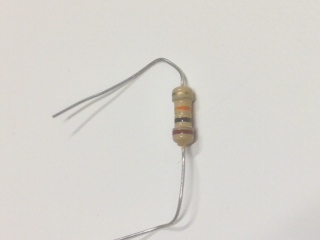
- Put the resistor so that one end is in the same row as the white wire, one pin to the right of the light sensor.
- Put the other end of the resistor in the same row but across the "well" – the right side of the breadboard.
- Put a green wire in the pin one to the right of the right side of the resistor into the 5V pin on the Arduino.
When assembled, it should look like this:

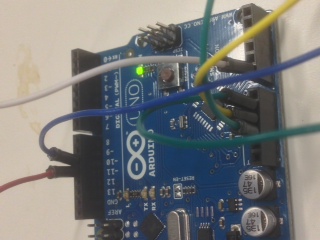
Testing it Out
We need a Ruby program to see if it’s working.
- Make sure to save any old work
- Create a new, blank file
- Save it with the name
nightlight.rb - Add the content below
1 2 3 4 5 6 7 8 9 10 11 12 | |
Then go to your command prompt and run the program:
1
| |
You should see a bunch of numbers scrolling by, mine says 62. Cover the light sensor with your hand and the number should jump up to over 150 – mine went to 182.
If you’re seeing numbers around 0 or 1000 there are problems with your circuit. Go up and work through the instructions again.
Reacting to the Light
Right now your nightlight has these lines:
1 2 3 | |
The code between the do and end gets run each time the Arduino measures the sensor, several times per second. The variable data is the numeric reading.
We saw that when the circuit is not covered, data was around 62. When it’s covered, data goes up to about 182.
Within that do/end, write Ruby code that…
- Looks at the
data - If it is higher than a certain number, print "It’s dark"
- If it is lower than the number, print "It’s light"
Watch out that data is a string. You probably want to convert it to an integer.
Activating the LED
Look back at your first project to remember the instructions for connecting to and turning on an LED.
- Add one line that will connect to the LED (look for
upper_led =) - Add a line that will set the LED to
:offwhen it is light - Add a line that will set the LED to
:onwhen it is dark
See if you can make it work. When it’s working, remove the puts lines from your Ruby so it just runs and changes the light without any text output.
Have someone verify your work.
Extensions
Here are some additional ideas to try:
Double-Bulb
Have you ever noticed how some cell phones actually get dimmer the darker it is outside? When it’s really dark, you don’t want a super bright light or it’s hard to see anything else!
Make it so your nightlight:
- Has no LEDs on when it’s full light
- Turns on both LEDs when it gets a little darker
- Goes down to just one LED when it’s very dark
Slow-Off
Maybe your light shouldn’t be so quick to turn off when exposed to light. Make it so when the outside light goes down, the LED(s) turn on instantly.
But, when the outside light increases, the LEDs stay on for five seconds.
